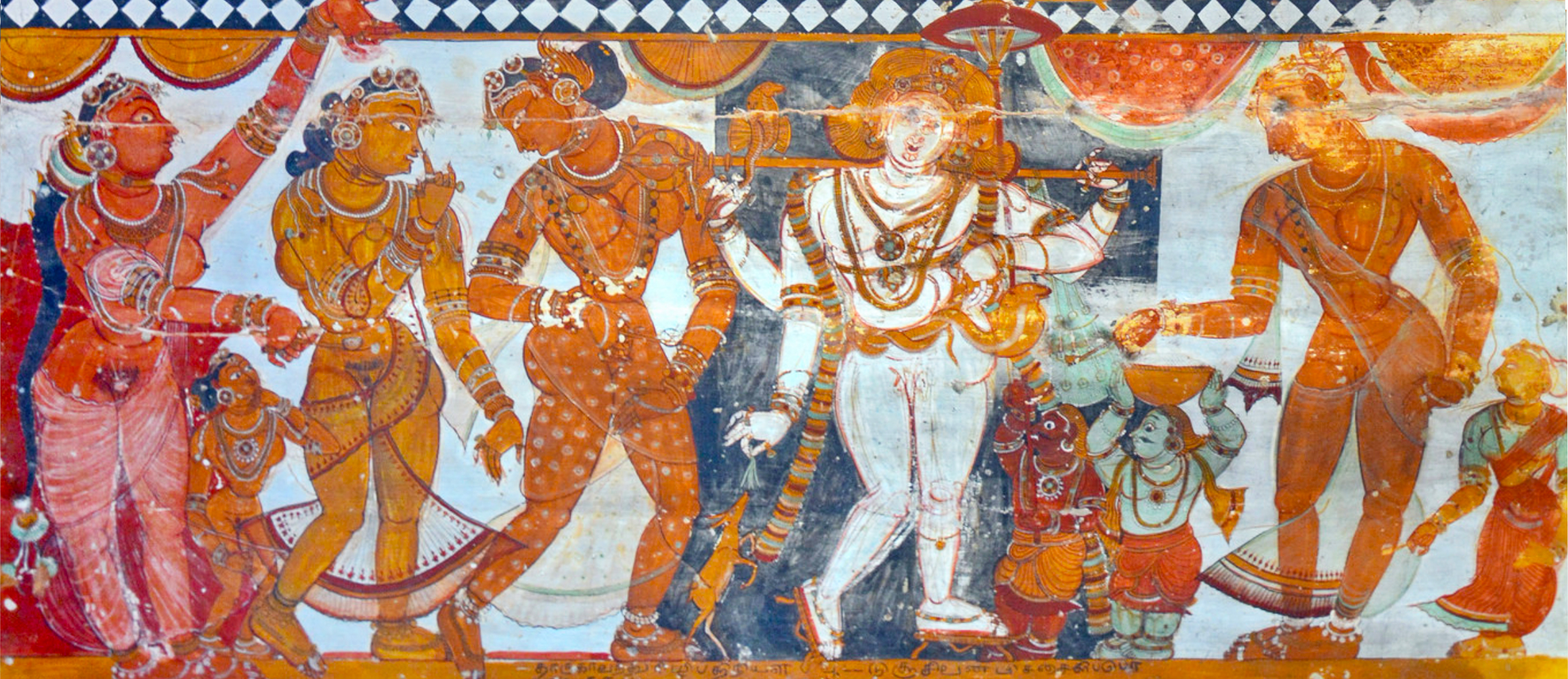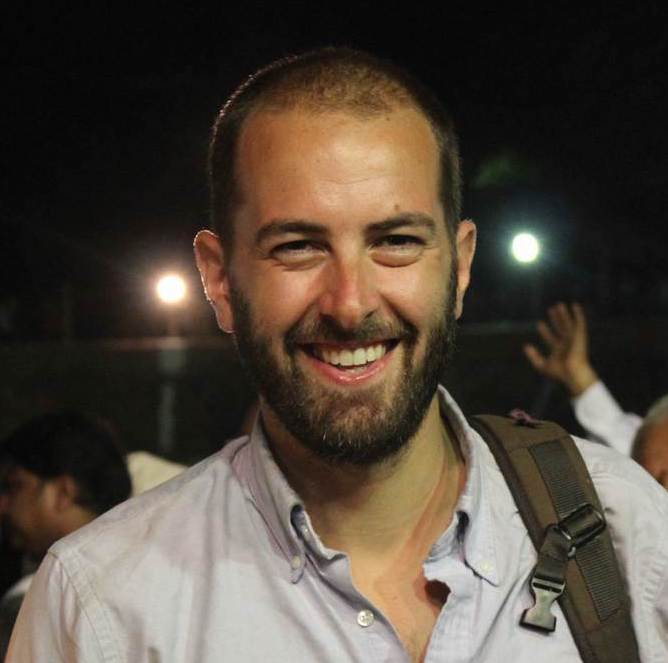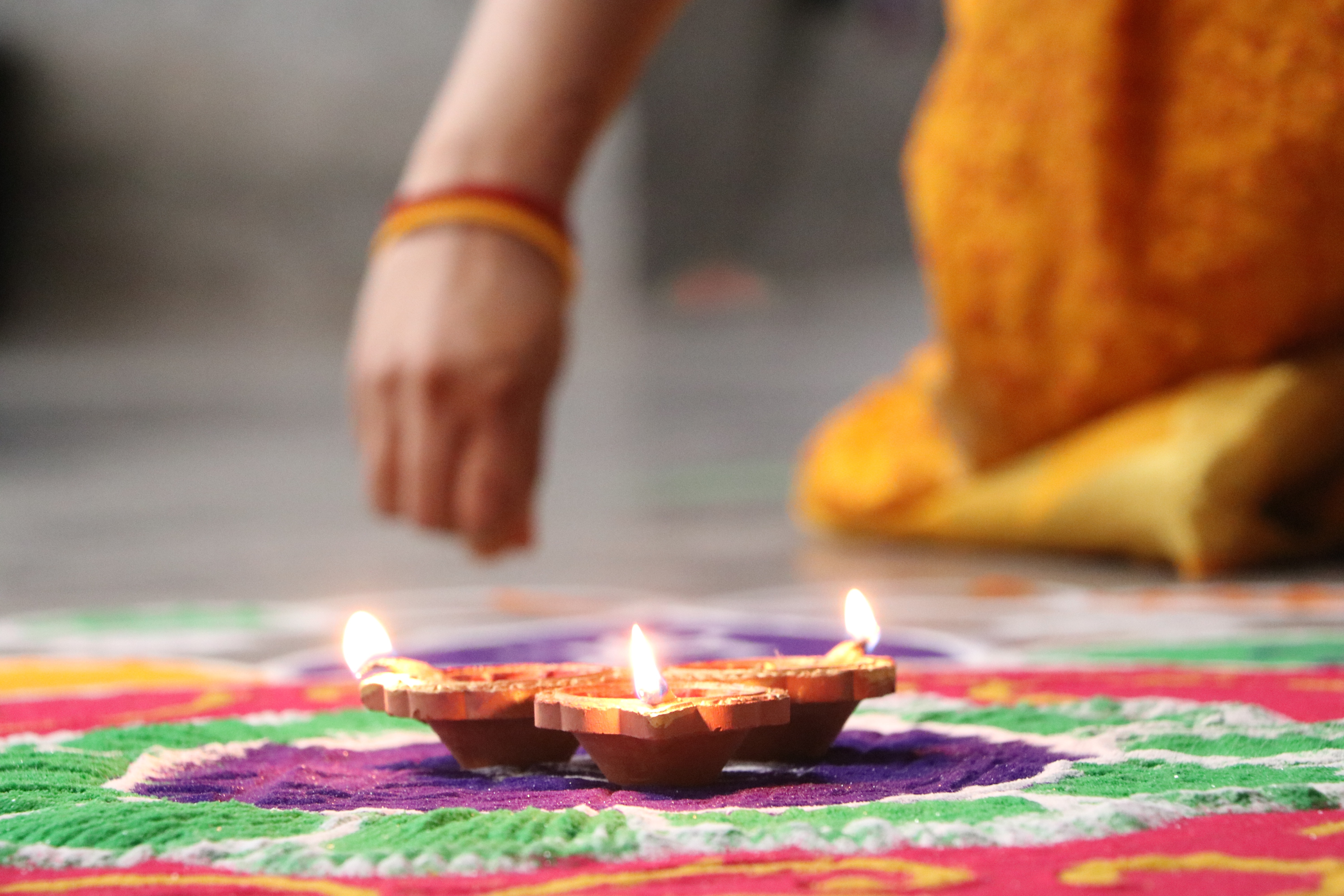Narrative Pedagogy and Transmedia Balancing
Children dressed as Lord Krishna wait for a fancy dress competition. Credit: Ajay Verma/Reuters
Introduction: Teaching Narratives, Using Transmedia
When I arrived at the University of Arizona as a new assistant professor in the Department of Religious Studies and Classics, I was tasked with building the curriculum on South Asian religions. In fact, the only course that was on-the-books and related to my area of expertise—Hinduism—was an older holdover from the university’s “Department of Oriental Studies.” This course was titled “Hindu Mythology.” While the title seemed a bit outdated (and I worried if the title was “sexy” enough to draw in students), I was thrilled that I would be able to teach this course because it gave me a perfect opportunity to teach through narratives, and the old-fashioned title would serve to set the tone of the course in which we could problematize both the categories of “Hinduism” and “myth.” Indeed, structuring a course entirely around Hindu narratives proved to engage students and introduce them to the variety of traditions under the rubric of Hinduism, and it also helped them understand its history as it is embedded within the texts that we encounter. While the course proved to be—I guess the title was sexier than I thought—and I could see students engaging with the narratives in a way that they often don’t with textbooks, in many ways I felt like I was doing the tradition a disservice because, intentional or not, I was reifying a model of studying and teaching religion (largely based on Protestant Christian theology) that privileged textual sources over other sources of religious knowledge.
Not willing to give up on the immense benefits of using narrative to teach religion, I began implementing what I call transmedia balancing in my courses. By transmedia balancing, I refer to the incorporation of various media in the classroom that both exhibits the diverse range of sources for religious knowledge and seeks to activate in students multiple learning fluencies about the same subject matter. When learning about any given narrative, I introduce various iterations of the story in a variety of media simultaneously, and the students are asked to “read” and interpret Hindu myth through 3D sculptures, paintings, performances (dance, theatrical, and folk), films, and 360-degree visualization of interiors of temples and palaces that are decorated with murals, in addition to Sanskrit and vernacular texts. The benefits are three-fold. First, by balancing the sources of knowledge, I am confident that I am more accurately representing the variety that exists within the Hindu traditions and the ways that practitioners have engaged with their tradition and their narratives throughout its long history. Second, the use of various media engages various learning styles, targeting visual, aural, physical, as well as verbal, learners. Third, this method works to unsettle many of the students’ underlying assumptions about the primacy of textual knowledge and requires them to develop fluencies in multiple ways of knowing. By learning to stack and integrate multiple fluencies, learners can expand their understandings of a subject well beyond what is typically possible in a conventional classroom. In this way, this pedagogical technique can provide a classroom atmosphere that is more holistic in form and function, that makes use of the tools at our fingertips during this New Media Age, and that more closely reflects that broad spectrum of media through which knowledge has been produced and transferred since antiquity.
Transmedia Balancing and the Pedagogical Value of Multiple Narratives
As many of the essays in this issue demonstrate, there are immense benefits to using narrative to foster greater student engagement. From the dynamic nature of Purāṇic narratives to devotional storytelling’s function in crafting and shaping subjectivities, narrative multiplicity in the Hindu traditions allows learners to move beyond rote memorization of details and to mine narratives for beliefs and practices embedded within. It allows them to investigate the messy intersections of narrative difference and the many disparate contexts that influence negotiations of narrative details. The insight into the tradition that this affords is invaluable and gives learners an opportunity to activate their knowledge of historical development and sectarian difference by interpolating these factors alongside narrative change. It teaches students to become close readers and forces them to activate the core concepts that they are learning by seeing them within the text. For my transmedia assignments, I expand the narrative pedagogical model to include nontextual iterations of narratives to add another level of dynamism to the discussion. Incorporating new media such as 3D sculptures and 360-degree visualizations draw students into a world in which they have to interact with the object of study by manipulating their point of view (using software like Adobe Flash or websites/apps such as Facebook360 or SketchFab). With simple tools readily available, we can introduce these various media into our courses, using websites and apps where the content is already available and free.
One of my favorite narratives to teach in “Hindu Mythology” is the story of Śiva as Bhikṣāṭana (the mendicant beggar), the ṛṣis of the Pine Forest, and their wives. This story is rife with interesting topics for discussion, from renouncer traditions and asceticism to the concepts of devotion and sexuality, in addition to providing an opportunity to discuss how different North and South Indian Hinduism can often be from each other. I begin this assignment as I do all the others by providing a brief skeletal outline of the narrative orally in-class and a printed version for students to refer to, giving everyone a baseline to understand the particular version of the narrative that they are about to examine.
Bhikṣāṭana is a deity [I leave it vague so they can use the clues in the narratives to figure out which deity it is] who goes to the forest to see his devotees who are practicing austerities and show them the virtues of the dharmic householder life. Using this as your guide, examine the fuller narrative in the medium assigned to your group. Be sure to look for elements that point to sectarian and devotional traditions, ritual practice, and asceticism v. householder life.
With prompt in hand, the class divides into prearranged, semester-long groups, and each group is given the narrative (here: Bhikṣāṭana) in a different medium. It looks something like this:
Group A: 3D rendering of relief sculpture from Kailāsanātha temple in Kañcipuram, Tamil Nadu.(Note: the students have been prepped for reading images within the South Asian context through a series of Hindu iconography lectures in which I discuss major themes, such as mudrās or hand gestures, sectarian symbols, weapons, hair styles, etc.)
Group B: image of ceiling mural at Chidambaram (see Figure 1).

Figure 1: Bhikṣāṭana and the ṛsis’ wives on the ceiling of Śivakāmasundari Temple in Cidambaram
Group C: Translation of selections from Tēvaram (Tamil devotional poetry) about Bhikṣāṭana from Indira Viswanathan Peterson’s Poems to Śiva (Princeton University Press, 1989).
Group D: Translation of selections from Śivakoṭirudra Saṃhita of the Śiva Purāṇa (Sanskrit Purāṇaic narrative) about Bhikṣāṭana from Cornelia Dimmit and JAB van Buitenen’s Classical Hindu Mythology (Temple University Press, 1978).
Each group is then required to work together to flesh-out the fuller Bhikṣāṭana narrative paying particular attention to the clues contained in their group’s rendering of the story. The groups use the information that they glean from their medium to create a presentation in which they relate the full narrative of Bhikṣāṭana and the ṛṣis’ wives, highlighting the emphases found in their version of the story.
Throughout the semester, the groups are given different narrative media in order to help them develop a broader range of interpretative tools. Other media include videos on YouTube and Vimeo, 360-degree visualizations that I have created of various muraled temples, and even recordings of local Hindus telling mythic narratives from their own recollection (this has proved to be both a class favorite and a very effective tool for audible learners). The goal is to introduce students to the widest possible range of sources throughout the entire semester; thereby debunking any pre-existing notion that there is one authoritative version of these narratives, and forcing students out of a text-first mentality. Additionally, it aids the students in a fuller understanding of the material as they are forced to encounter it through a variety of perspectives.
Multiple Stories, Multiple Media, and Multiple Fluencies
As you have probably already picked-up on, my approach of balancing transmedia in narrative pedagogy is designed to resist the hegemony of the printed word—an understandable development given the democratizing impact of the printing press, but one that also ultimately determined an economic and ideological course for education that strongly favored the printed word over other media. Today, this bias is felt more sharply than ever before by both teachers and students, largely because alternative modes of information conveyance—from photography and videography to 3D-modeling and virtual reality—become more accessible to more kinds of people every day. Indeed, despite the fact that text’s primacy in teaching and learning contexts is a near certainty for decades to come, studies increasingly indicate that the greater variety of media used in instructional materials directly corresponds to increased learning outcomes and proficiencies among students across all academic disciplines (Stelzer et al., 2009; Rolfe and Gray, 2011; Gu et al., 2015). As university curricula become ever more invested in teaching students to become transdisciplinary, a new instructional challenge emerges: how can we leverage the wide range of emerging educational tools to make learning more engaging, adaptive, and agile?
I believe that the answer lies in linking our pedagogy with both premodern and state-of-the-art ways of learning. As a scholar of religion, history, and art, it is clear to me that there exists a large variety of ways through which people created and disseminated knowledge in both textual and nontextual contexts, and more often than not—especially in the context of South Asia—the method of conveyance was through stories. Indeed, the Hindu traditions have a long and rich literary and nonliterary history, wherein we can see how varieties of textual, oral, visual, and tangible media were, and continue to be, used to disseminate information through the stories they tell. By mimicking the variety of ways that knowledge was disseminated in and through text, image, and performance, and applying this methodology within the context of contemporary education, we can develop more well-rounded students who are proficient in a variety of learning techniques. Starting with the idea that different media enable different modes of information transfer and thus different ways of knowing, I believe that the use of transmedia balancing within modern educational contexts can make a meaningful difference creating a dynamic atmosphere of learning that reflects both premodern and contemporary concerns. The variety and longevity of narrative dramatically illustrates how the balancing of textual and nontextual fluencies has the potential to serve modern learners even more than it did their premodern counterparts, especially given the technological tools at our disposal.
Transmedia Balancing beyond the Hindu Studies Classroom
While the sample assignment and the overall pedagogical method that I argue for in this essay clearly result from the context of my research and the subject matter I teach—and is therefore designed to speak to that specific milieu—the use of a variety of media in religious studies classrooms is hardly a novel idea, and I learned many of the strategies that I implement from other scholars within the discipline across a range of topics. I, however, think that there is additional value in the practice of transmedia balancing for those of us who teach with and about narratives (it is also worth bringing up for those who aren’t aware of some of the tools available). I believe that this would be an extremely worthwhile teaching practice (maybe even more effective) for scholars of religions that focus on textual authority because the introduction of different traditional media can help shoulder some of the theoretical work that goes into questions of authority, canon, and the multiplicities that always exist in any religious tradition. I could see it also having immense benefits for subject matter relating to nontextual traditions: I’ve always found it odd that we often learn about oral traditions through texts. Beyond content, it is increasingly important that we adapt to the changing environment in which we find ourselves. Our students have a variety of different skills and learning styles, and it is up to us to engage them using all the tools at our disposal and help all students acquire fluency in a variety of transmedia applications.
 Caleb Simmons is assistant professor in the Department of Religious Studies and Classics at the University of Arizona where he specializes in religion in South Asia, especially Hinduism. His research specialties span religion and state-formation in medieval and colonial India to contemporary transnational aspects of Hinduism. His recently completed book project, Devotional Sovereignty: Kingship and Religion in Early Modern Mysore (currently under review), examines how the early modern court of Mysore re-envisioned notions of kingship, territory, and religion, especially through articulations of devotion. He is currently working on a second monograph, Singing the Goddess into Place: Folksongs, Myth, and Situated Knowledge in Mysore, India, which examines popular local folksongs that tell the mythology of Mysore's Chamundeshwari and her consort Nanjundeshwara. He edited (with Moumita Sen and Hillary Rodrigues) and contributed to Nine Nights of the Goddess: The Navarātri Festival in South Asia (SUNY Press, 2018). He teaches courses on Hinduism (including “Hindu Mythology”), Indian religions, and religious studies theory.
Caleb Simmons is assistant professor in the Department of Religious Studies and Classics at the University of Arizona where he specializes in religion in South Asia, especially Hinduism. His research specialties span religion and state-formation in medieval and colonial India to contemporary transnational aspects of Hinduism. His recently completed book project, Devotional Sovereignty: Kingship and Religion in Early Modern Mysore (currently under review), examines how the early modern court of Mysore re-envisioned notions of kingship, territory, and religion, especially through articulations of devotion. He is currently working on a second monograph, Singing the Goddess into Place: Folksongs, Myth, and Situated Knowledge in Mysore, India, which examines popular local folksongs that tell the mythology of Mysore's Chamundeshwari and her consort Nanjundeshwara. He edited (with Moumita Sen and Hillary Rodrigues) and contributed to Nine Nights of the Goddess: The Navarātri Festival in South Asia (SUNY Press, 2018). He teaches courses on Hinduism (including “Hindu Mythology”), Indian religions, and religious studies theory.
Further Reading
Chamberlain, Daniel F., and J. Edward Chamberlin, eds. Or Words to That Effect: Orality and the Writing of Literary History. UK ed. edition. Philadelphia: John Benjamins Publishing Company, 2016.
Gu, Xiaoqing, Bian Wu, and Xiaojuan Xu. “Design, Development, and Learning in e-Textbooks: What We Learned and Where We Are Going.” Journal of Computers in Education 2, no. 1 (March 1, 2015): 25–41.
Rolfe, Vivien E., and Douglas Gray. “Are Multimedia Resources Effective in Life Science Education? A Meta-Analysis.” Bioscience Education 18, no. 1 (December 1, 2011): 1–14.
Stelzer, Timothy, Gary Gladding, José P. Mestre, and David T. Brookes. “Comparing the Efficacy of Multimedia Modules with Traditional Textbooks for Learning Introductory Physics Content.” American Journal of Physics 77, no. 2 (January 12, 2009): 184–90.

